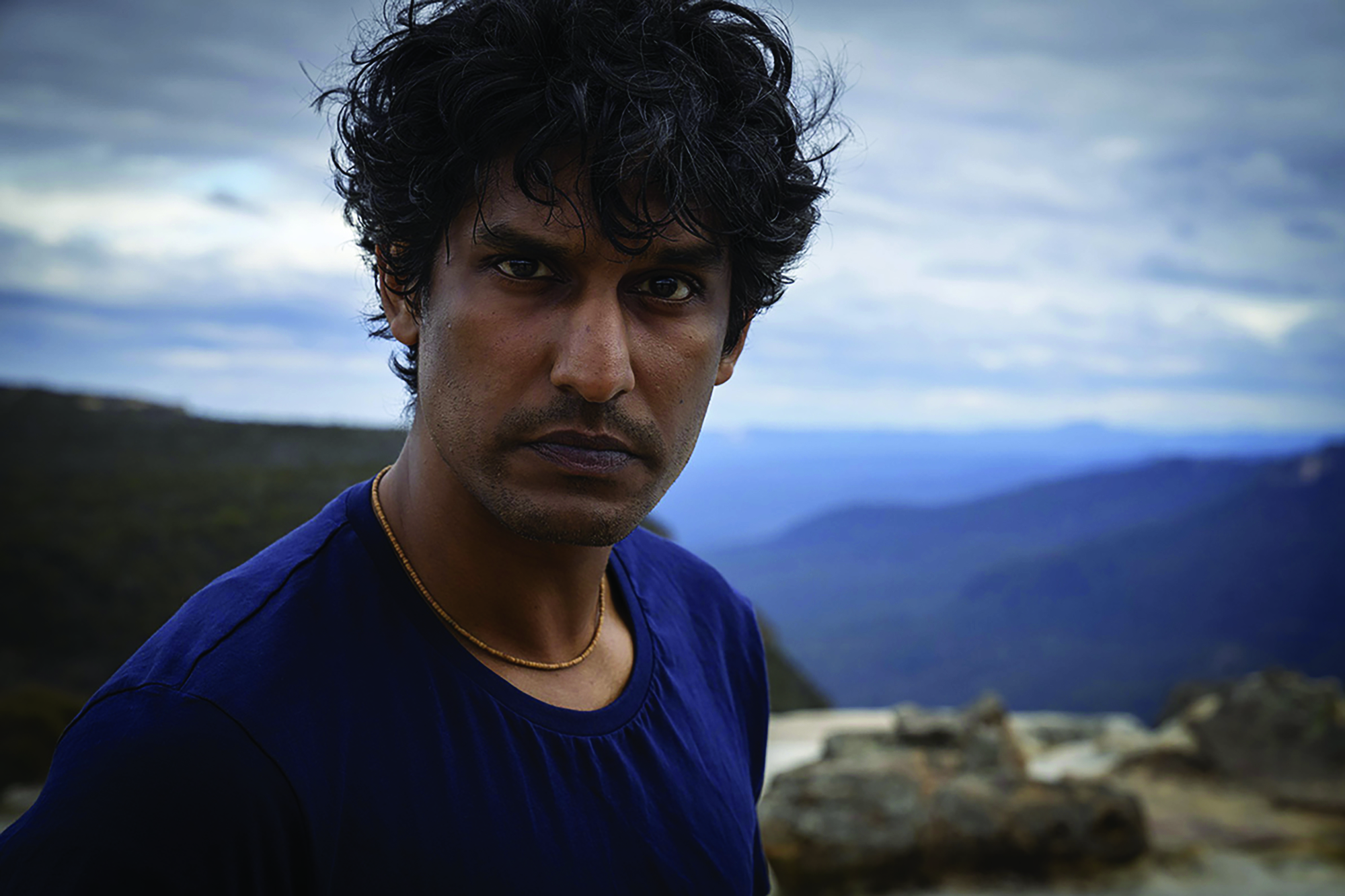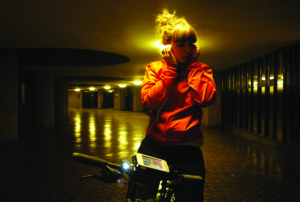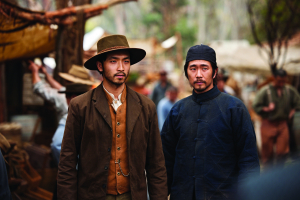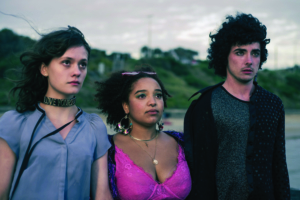The eight-part 2021 ABC series Wakefield, created by Kristen Dunphy and directed by Jocelyn Moorhouse and Kim Mordaunt, follows psychiatric nurse Nik (Rudi Dharmalingam) as he negotiates his way through his world of patients, colleagues, family and ultimately his own fragile psyche. He works at the facility that gives the series its name, a small psychiatric hospital in rural New South Wales; although his colleagues refer to him as ‘the sanest person in this place’, Nik finds himself mentally unravelling.
The series’ ensemble cast allows for an exploration of mental health in all its messy, upsetting and challenging detail across a range of recognisable and relatable characters. Along with making great use of its picturesque Blue Mountains setting, Wakefield also explores these characters’ relationships with the real and imagined spaces that they encounter throughout their mental-health journeys.
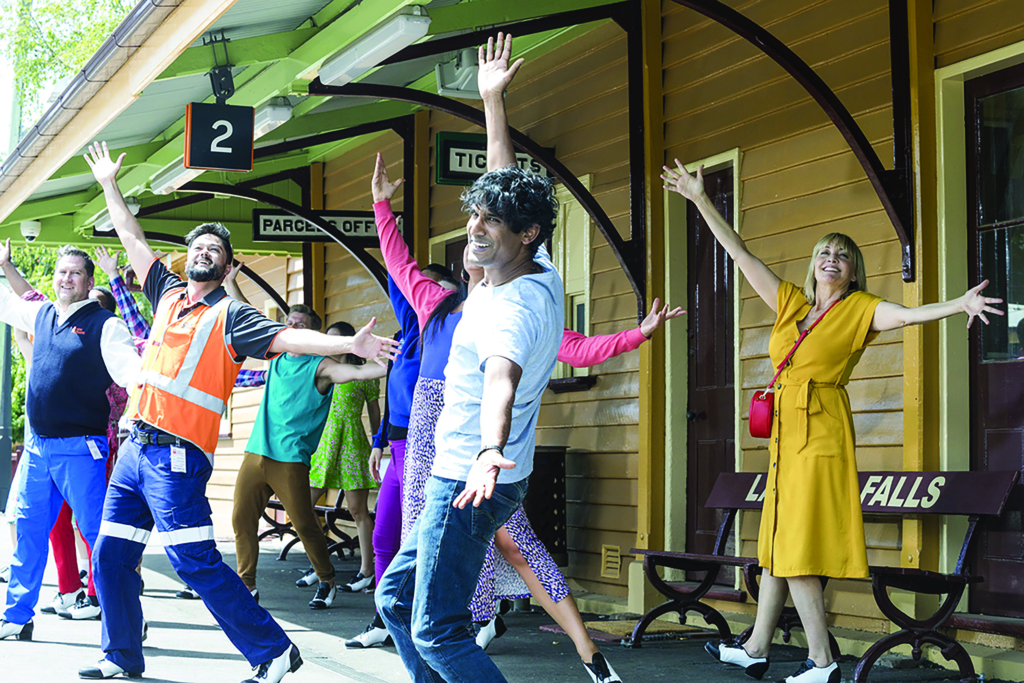
Freedom and fear
The series takes time in each episode to feature the spectacular landscape of the Blue Mountains through soaring aerial shots above the hospital. However, this is not merely for aesthetic purposes: the outdoor space symbolises the opposing emotions experienced in particular by Nik and Wakefield psychiatrist Kareena (Geraldine Hakewill). The pair have history – they were once engaged, and while he remains single, she is now married – and their unresolved feelings are often at odds with their professional relationship.
Nik’s fear of heights, for instance, is exacerbated by the surrounding mountainous landscape. We see him at the edge of the same precipice at the beginning and end of the first episode, it being unclear whether he is about to jump or fall. Nik returns to this familiar yet terrifying location at several points in the series. The camerawork emphasises the dizzying heights with slow pans up waterfalls, revolving swirls downward and fast, stomach-churning drops that replicate the experience of falling. At the same time, though, the landscape gives Nik a sense of freedom from the confines of the hospital, his home and his own thoughts.
For Kareena, the landscape represents freedom from the constraints and responsibilities of the hospital and her home life. While she often runs the mountain tracks to clear her head, she also competes with unseen runners in a smartwatch app. Her need to be in control and conquer all aspects of her life is something her therapist broaches in sessions aimed at resolving her sexual dysfunction: in the intimate space of the marital bedroom, Kareena is unable to climax, but in the vast outdoor space of the mountains, where she is fully in control of her mind and body, she masturbates alone by a waterfall. This sense of freedom, however, is also mixed with a disorientation – a feeling conveyed through soaring aerial shots of vast, dense vegetation – that she feels outdoors, a juxtaposition that is revisited throughout the series. Kareena’s sense of helplessness in these conditions has been triggered by an incident in which she got lost while driving, arriving too late to save a patient who took their life on one of the clifftops. These exteriors connect her and Nik in another way: when she finds herself lost again while driving, he is the one whom she calls to guide her back.
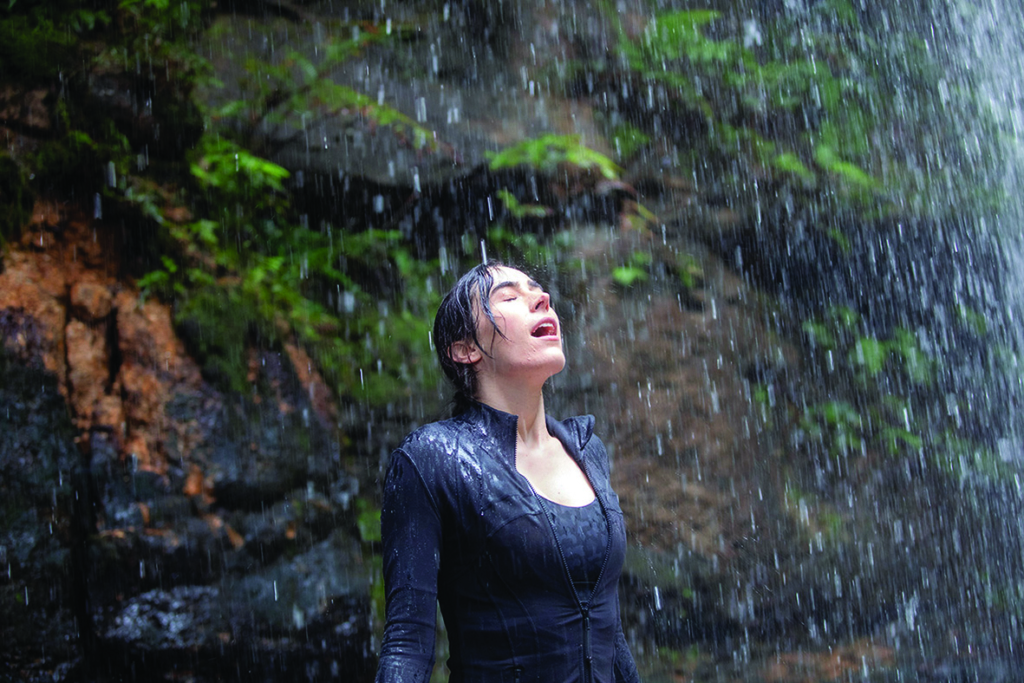
Between fantasy and reality
Within the hospital, characters appropriate spaces to fit their reality. When we first encounter workaholic businessman James (Dan Wyllie), we are convinced for a moment that he is in his workplace – he is seen in a business shirt and tie, and on a phone call – but an interruption from a fellow patient and a change of camera angle shows us that he is wearing pyjama pants and is, in fact, a patient at Wakefield. He later holds an international Skype call in a broom closet, ‘set dressing’ the background with a pot plant so that the laptop camera frame captures what could be an office. Young patient Tessa (Bessie Holland) similarly transforms her space into an inner world, covering her hospital bedroom (including its outer door) wall to wall with her drawings. The significance of her need to fill the space in order to feel comfort is revealed by her mother, who, in discussing Tessa’s hoarding tendencies, cruelly refers to her as a ‘cockroach’.
There are also scenes in which the reality of spaces is transformed by unreal, imagined elements. Patient Ivy (Megan Smart), who has suffered severe postnatal depression and is at Wakefield with her baby, becomes increasingly distraught one evening when her daughter is crying. The bars of the baby’s crib and those on the windows seem to transform into prison bars, with eerie shadows and light playing in the room as her anxiety builds. She runs into the hospital grounds, with the canted camera framing and projections of her daughter’s crying face on cliffs building to horror-movie intensity before Nik finally finds her.
The way Genevieve touches the soil recalls the image of Kareena’s hands touching the mossy rocks in her masturbation scene; both women experience a purity in their respective connections with the earth and their sexuality.
When we meet bipolar patient Genevieve (Harriet Dyer), we are immediately plunged into her fantasy world, within which she is making love in a lush garden. The harsh reality of this scene is eventually revealed – she is having sex with a stranger in a hospital utility closet, the result of a manic episode. We come to learn that Genevieve is a landscape gardener; drawing on this knowledge, Nik attempts to channel her energy into engaging with the garden outside. As she walks barefoot through the grass and lovingly plants a small tree, the camera conveys her relationship with these natural elements as tactile and sensual. Fantasy interferes again when she imagines a beautiful lion in the foliage before her. Interestingly, the way Genevieve touches the soil recalls the image of Kareena’s hands touching the mossy rocks in her masturbation scene; both women experience a purity in their respective connections with the earth and their sexuality.
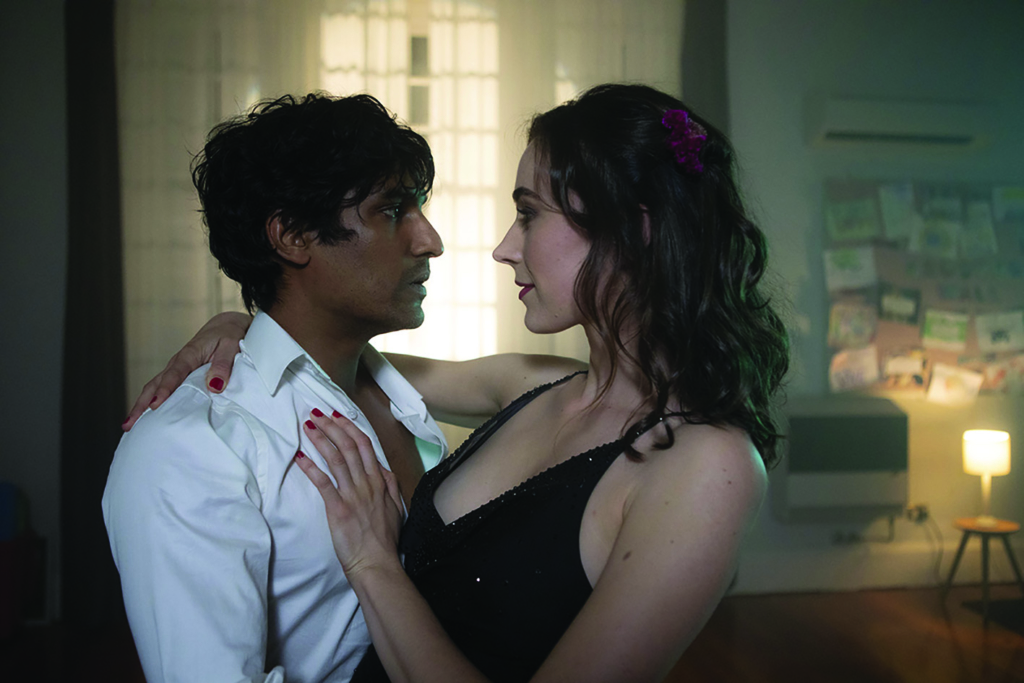
Another great example of what critic Luke Buckmaster describes as the series’ commitment to ‘exploring the inner and outer worlds of its characters’[1]Luke Buckmaster, ‘Wakefield Review – Superbly Made and Utterly Riveting Series Based in a Psych Ward’, The Guardian, 3 April 2021, <https://www.theguardian.com/tv-and-radio/2021/apr/03/wakefield-review-superbly-made-and-utterly-riveting-series-based-in-a-psych-ward>, accessed 1 September 2021. occurs when James returns to the hospital from an ill-fated sojourn into the real world of work, so ashamed of his relapse that he covers his head with a blanket as he is wheeled in by Nik. His deep depression transports his bed into the landscape outside, which is not the same one we have seen throughout the series, but stark, blackened and ravaged by bushfire. Naked, he walks to a tree and, as he leans against it, is slowly absorbed into the landscape. This need to escape himself so completely culminates in a suicide attempt.
For Nik, mundane spaces are transformed into something fantastical, a process often accompanied by musical numbers. As critic Anthony Morris has observed, these sequences provide a visual way to express Nik’s disconnection with others.[2]Anthony Morris, ‘TV Review: Wakefield Succeeds with Equal Opportunity Compassion’, Screenhub, 16 April 2021, <https://www.screenhub.com.au/news-article/reviews/television/anthony-morris/tv-review-wakefield-succeeds-with-equal-opportunity-compassion-262276>, accessed 1 September 2021. In a scene in Episode 1, Nik is sitting at the train station and hallucinates Ivy pushing her baby’s pram in front of an oncoming train. When we return later in the episode, the entire platform of people breaks into a tap-dance sequence to Dexys Midnight Runners’ ‘Come On Eileen’ (an earworm that he is unable to shake).The commuters’ clothes are now bright colours, but Nik looks the same apart from his black-and-white childhood tap shoes. While the scene is unexpected and entertaining, it also signals Nik’s descent into mental anguish, as his insomnia (made worse by the earworm) worsens and his grip on reality slips away. We see the hospital’s common room transform into a romantically lit dance floor for Nik and Kareena, hinting at their unresolved feelings. The sequence ends with a decidedly unromantic thunk when Kareena’s face becomes that of Nik’s work nemesis Linda (Mandy McElhinney). In a later sequence in this same space, Nik becomes an unwilling observer rather than a participant while Linda mimes to Hot Chocolate’s ‘Every 1’s a Winner’ in sexy equestrian gear, backed up by top-hatted dancers consisting of staff and patients. Through these sequences, we see how Nik’s sense of control over his workspace is being invaded by Linda’s confidence and manipulation.
At the bucks’ party for his sister’s fiancé, which is held at a karaoke venue, Nik again pictures Kareena walking into his space in a sexy red dress, but as he sings Gotye’s melancholic ‘Somebody That I Used to Know’, his fellow male partygoers join him on stage in a tap-dance routine, all wearing the signature black-and-white tap shoes. This repeated motif of Nik tap-dancing is key to his mental unravelling, representing a deep-seated fear and self-loathing. We see him as a child (Nirish Bhat Surambadka) being struck by his mother, Jeshna (Nadie Kammallaweera), when the sound of him tap-dancing overwhelms her. Nik also makes a comment early in the series that his father, Rashaal (Shapoor Batliwalla), told him as a child that boys shouldn’t tap-dance. At one point in the series, the mirrors in Nik’s bedroom wardrobe depict three versions of himself – as his present-day adult self, as a pre-teen (Kershawn Theodore) and as a child – dancing together. It is clear from this imagery that he must reconcile these three points in his life in order to find the source of his trauma.
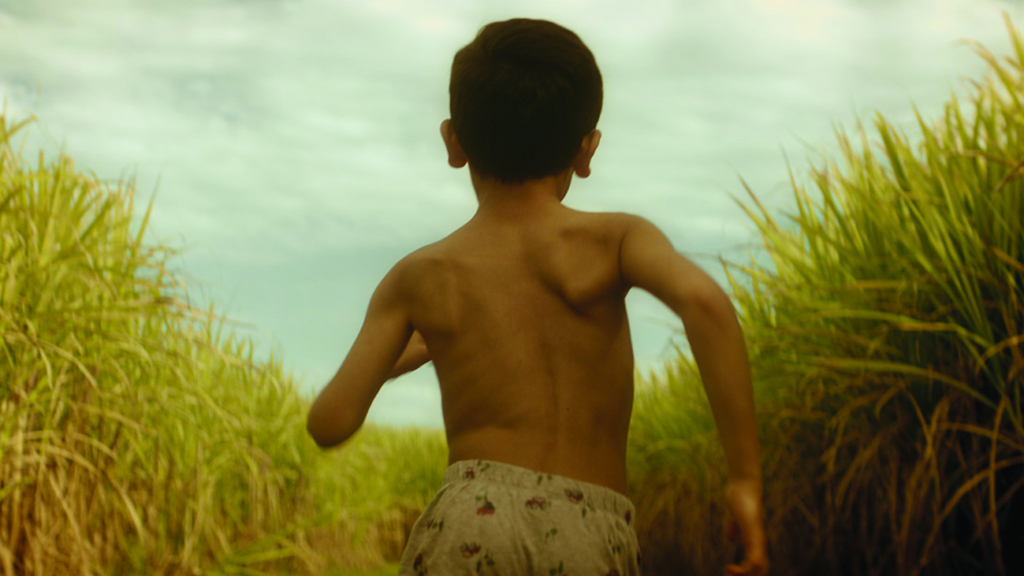
Completing the puzzle
In Wakefield’s common room, Tessa begins a jigsaw puzzle, which she works on over the course of the series. Within this highly controlled space, she is free from the chaos of her room and has a renewed sense of purpose. While she is initially possessive towards this project, she later allows James to help, the shared therapeutic activity binding them in an unlikely friendship. The puzzle itself is symbolic of the structure of the series: pieces of the story are added a little at a time, and sections are added to, left temporarily or returned to later. Scenes are revisited from multiple character perspectives, and the temporal order of events is often unclear to the viewer until the end of each episode. This patchwork approach reflects the nature of both memory and mental health: we don’t always remember in a clean, linear fashion; we often return to events in memory in a piecemeal or distorted way; and mental illness can cloud, confuse or amplify the emotions of remembered events.[3]As Dunphy has put it, ‘Psychiatry is a very inexact science […] which is why we chose a puzzle as a key image of the series.’ Kristen Dunphy, quoted in Katy Marriner, Wakefield, study guide, ATOM, Melbourne, 2021. This unique storytelling approach allows the lives of the characters to be revealed gradually, both to the audience and to one another.
The completion of the jigsaw puzzle precipitates Nik’s final confrontation with his past. The search for the last piece of the puzzle – which forms a blue butterfly, a visual motif in the series – reveals the missing piece of Nik’s story. As he pulls the common room apart searching for the piece in an increasingly frenzied manner, the staff and patients look on in awe and fear. He is literally destroying their familiar shared space, transforming it into a chaotic mess that mirrors his own mental state. When he is locked in the bathroom for his own safety, the choice of room could not be worse: water is a trigger for Nik’s traumatic memories. In previous scenes, he has remembered being baptised as a teen; but in his nightmares, he has turned into his adult self, finding himself unable to reach the surface and drowning. At his sister’s wedding, Nik has discovered that his little brother drowned in the bath, not a river, as he grew up believing. As he stands under the shower at Wakefield, the room fills with water, transforming from a real space to an unreal one. This forces him to confront his brother’s death, which, it is revealed, he not only witnessed but also inadvertently caused while tap-dancing in the bathroom. As Buckmaster asserts, this climax, in which Nik’s ‘mental floodgates are opened to various memories’, is a ‘powerful and moving look at trauma’.[4]Buckmaster, op. cit.
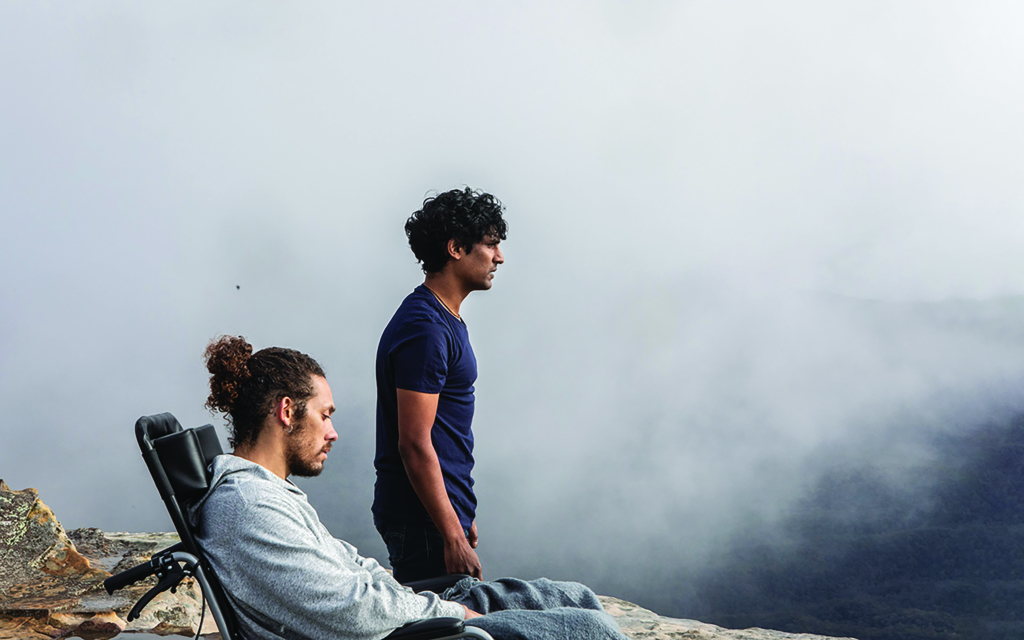
Despite its serious subject matter, there are many moments of laughter and redemption in Wakefield. One of Nik’s tap-dancing routines – shared with catatonic patient Omar (Richie Miller) on top of Govetts Leap – is particularly poignant and uplifting, combining the breathtaking yet dangerous locale with an expression of pure joy and freedom. Wakefield’s greatest achievement is that we are invited to view the show’s characters, patients and clinicians alike, on a ‘spectrum of mental health’[5]Fincina Hopgood, ‘Wakefield – New ABC Series Looks at Mental Health and Treatment from the Inside Out’, The Conversation, 6 April 2021, <https://theconversation.com/wakefield-new-abc-series-looks-at-mental-health-and-treatment-from-the-inside-out-157414>, accessed 1 September 2021. – and experience their interactions with spaces and places, real and imagined, through their eyes, rather than as mere observers.
Endnotes
| 1 | Luke Buckmaster, ‘Wakefield Review – Superbly Made and Utterly Riveting Series Based in a Psych Ward’, The Guardian, 3 April 2021, <https://www.theguardian.com/tv-and-radio/2021/apr/03/wakefield-review-superbly-made-and-utterly-riveting-series-based-in-a-psych-ward>, accessed 1 September 2021. |
|---|---|
| 2 | Anthony Morris, ‘TV Review: Wakefield Succeeds with Equal Opportunity Compassion’, Screenhub, 16 April 2021, <https://www.screenhub.com.au/news-article/reviews/television/anthony-morris/tv-review-wakefield-succeeds-with-equal-opportunity-compassion-262276>, accessed 1 September 2021. |
| 3 | As Dunphy has put it, ‘Psychiatry is a very inexact science […] which is why we chose a puzzle as a key image of the series.’ Kristen Dunphy, quoted in Katy Marriner, Wakefield, study guide, ATOM, Melbourne, 2021. |
| 4 | Buckmaster, op. cit. |
| 5 | Fincina Hopgood, ‘Wakefield – New ABC Series Looks at Mental Health and Treatment from the Inside Out’, The Conversation, 6 April 2021, <https://theconversation.com/wakefield-new-abc-series-looks-at-mental-health-and-treatment-from-the-inside-out-157414>, accessed 1 September 2021. |
